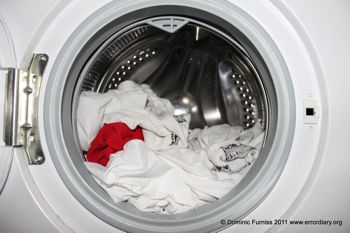A magazine where the digital world meets the real world.
On the web
- Home
- Browse by date
- Browse by topic
- Enter the maze
- Follow our blog
- Follow us on Twitter
- Resources for teachers
- Subscribe
In print
What is cs4fn?
- About us
- Contact us
- Partners
- Privacy and cookies
- Copyright and contributions
- Links to other fun sites
- Complete our questionnaire, give us feedback
Search:
The red sock of doom

A red sock in with your white clothes wash - guess what happened next? What can you do to prevent it from happening again? Why should a computer scientist care? Jo Brodie investigates. It turns out that red socks have something to teach us about medical gadgets.
How can we stop red socks from ever turning our clothes pink again? We need a strategy. Here are some possibilities.
- Don't wear red socks.
- Take a 'how to wash your clothes' course.
- Never make mistakes.
- Get used to pink clothes.
Let's look at them in turn - will they work?
Don't wear red socks: That might help but it's not much use if you like red socks or if you need them to match your outfit. And how would it help when you wear purple, blue or green socks? Perhaps your clothes will just turn green instead.
Take a 'how to wash your clothes' course: Training might help: you'd certainly learn that a red sock and white clothes shouldn't be mixed, you probably did know that anyway, though. It won't stop you making a similar mistake again.
Never make misteaks: Just never leave a red sock in your white wash. If only! Unfortunately everyone makes mistakes - that's why we have erasers on pencils and a delete key on computers - this idea just won't work.
Get used to pink clothes: Maybe, but it's not ideal. It might not be so great turning up to school in a pink shirt.
What if the problem's more serious?
We can probably live with pink clothes, but what happens if a similar mistake is made at a hospital? Not socks, but medicines. We know everyone makes mistakes so how do we stop those mistakes from harming patients? Special machines are used in hospitals to pump medicine directly into a patient's arm, for example, and a nurse needs to tell it how much medicine to give - if the dose is wrong the patient won't get better, and might even get worse.
What have we learned from our red sock strategies? We can't stop giving patients medicine and we don't want to get used to mistakes so our first and fourth strategies won't work. We can give nurses more training but everyone makes mistakes even when trained, so the third suggestion isn't good enough either and it doesn't stop someone else making the same mistake.
We need to stop thinking of mistakes as a problem that people make and instead as a problem that systems thinking can solve. That way we can find solutions that work for everyone. One possibility is to check whether changes to the device might make mistakes less likely in the first place.
Errors? Or arrows?
Most medical machines are controlled with a panel with numbered keys (a number keypad) like on mobile phones, or up and down arrows (an arrow keypad) like you sometimes get on alarm clocks. CHI+MED researchers have been asking questions like: which way is best for entering numbers quickly, but also which is best for entering numbers accurately? They've been running experiments where people use different keypads, are timed and their mistakes are recorded. The researchers also track where people are looking while they use the keypads. Another approach has been to create mathematical descriptions of the different keypads and then mathematically explore how bad different errors might be.
It turns out that if you can see the numbers on a keypad in front of you it's very easy to type them in quickly, though not always correctly! You need to check the display to see if you have actually put in the right ones. Worse, mistakes that are made are often massive - ten times too much or more. The arrow keypads are a little slower to use but because people are already looking at the display (to see what numbers are appearing) they can help nurses be more accurate, not only are fewer mistakes made but those that are made tend to be smaller.
Smart machines help users
A medical device that actively helps users avoid mistakes helps everyone using it (and the patients it's being used on!). Changing the interface to reduce errors isn't the only solution though. Modern machines have 'intelligent drug libraries' that contain information about the medicines and what sort of doses are likely and safe. Someone might still mistakenly tell the machine to give too high a dose but now it can catch the error and ask the nurse to double- check. That's like having a washing machine that can spot bright socks in a white wash and that refuses to switch on till it has been removed.
Building machines with a better ability to catch errors (remember, we all make mistakes) and helping users to recover from them easily is much more reliable than trying to get rid of all possible errors by training people. It's not about avoiding red socks, or errors, but about putting better systems in place to make sure that we find them before we press that big 'Start' button.


